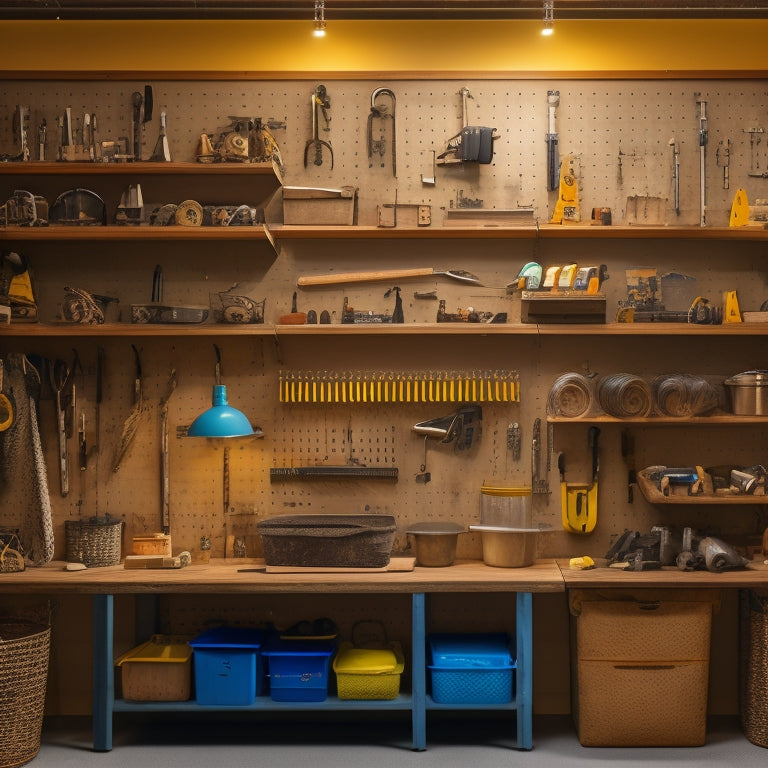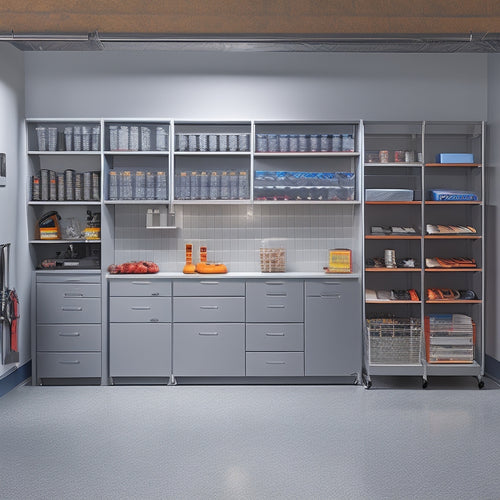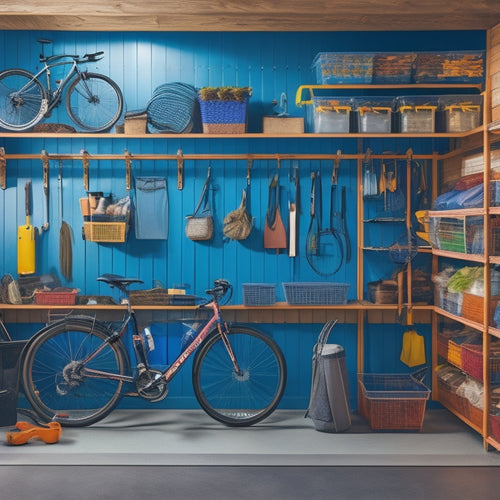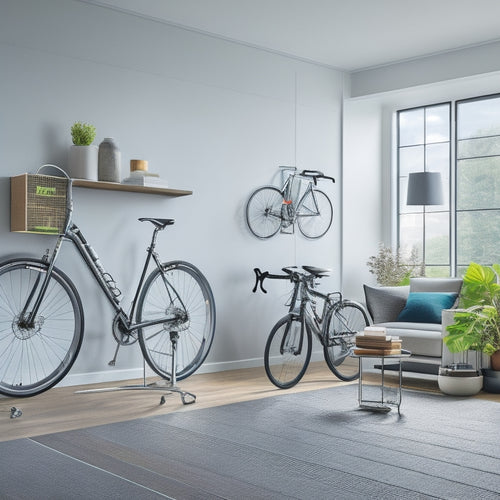
What's the Perfect Pegboard Design for Your Workshop?
Share
You'll want to start by evaluating your workshop needs, considering the types and frequencies of projects you tackle, the tools you use most often, and the available space. Then, choose a pegboard size that balances tool storage capacity with wall space, ensuring a visually appealing workspace. Select essential tool holders that are durable and rust-resistant, organized by critical categories. Customize the design for task efficiency, allocating space based on task frequency and prioritizing tools used most frequently. As you refine your design, you'll uncover the perfect blend of form and function that elevates your workshop's productivity and style, and takes your workflow to the next level.
Key Takeaways
• Assess your workshop's unique needs by considering project types, tool frequencies, and available space to optimize pegboard design.
• Balance tool storage capacity with wall space, factoring in tool dimensions and wall constraints for a visually appealing workspace.
• Organize tools into critical categories, providing dedicated holders for power and hand tools, and prioritize specific tools based on your work type.
• Customize pegboard space by allocating areas based on task frequency, prioritizing tools and accessories used most often, and optimizing efficiency.
• Ensure maximum efficiency and organization by utilizing vertical space, focusing on corner utilization, and incorporating ergonomic handles and color coding.
Assessing Your Workshop Needs
To optimize your pegboard design, you must first take stock of your workshop's unique requirements. Consider the types and frequencies of projects you undertake, the tools you use most often, and the available space.
As you assess your workshop needs, think about your workflow and how you move around the space. Do you have a dedicated area for specific tasks, or do you tend to work on projects in a more fluid manner? This will help you determine the most efficient layout for your pegboard.
Your personal preferences also play a significant role in designing an effective pegboard. Think about the tools you use daily and those you only use occasionally. You'll want to prioritize easy access to your most frequently used tools, while keeping less-used items organized but out of the way.
Consider the height and ergonomics of your pegboard, ensuring it's comfortable to use and reduces strain on your body. By understanding your workshop's specific needs and your personal work style, you'll be able to create a pegboard design that streamlines your workflow and boosts productivity.
Choosing the Right Pegboard Size
With your workshop needs and personal preferences in mind, you'll need to determine the best pegboard size that balances tool storage capacity with available wall space and accessibility. This delicate balance is vital for achieving a functional and visually appealing workspace.
Consider the dimensions of your most frequently used tools and the space required to hang them efficiently. A larger pegboard may provide ample storage, but it may also overwhelm your workshop's aesthetic. Conversely, a smaller pegboard might struggle to accommodate your tool collection. Pegboard aesthetics play a significant role in this decision, as a well-designed board can enhance your workshop's overall ambiance.
Wall constraints are another essential factor to take into account. Measure your available wall space carefully, taking note of any obstacles like electrical outlets, windows, or doorways. A pegboard that fits snugly within these constraints will maximize your storage capacity while maintaining a clutter-free environment.
Selecting Essential Tool Holders
When selecting essential tool holders for your pegboard, you'll need to identify the must-have tool categories that'll maximize your workshop's efficiency.
You'll also want to take into account the materials used to construct each holder, as durability and rust-resistance are important factors.
Essential Tool Categories
Organize your pegboard into essential tool categories, such as cutting, drilling, and fastening, to make sure that you're selecting the most critical tool holders for your workshop's specific needs. This will guarantee you're not wasting space on unnecessary holders and that your most-used tools are easily accessible.
Power tools, like drills and saws, should have dedicated holders to keep them organized and prevent damage. Hand tools, such as hammers and pliers, should also have their own designated spots to prevent clutter and make them easy to grab when needed.
Within these categories, consider the specific tools you use most frequently. If you're a woodworker, you may want to prioritize holders for chisels and hand saws. If you're a mechanic, you'll want to focus on holders for wrenches and sockets.
Tool Holder Materials
Selecting the right tool holder materials is essential to ensuring your pegboard design withstands heavy use and maintains its functionality over time. You'll want to choose materials that provide durability, corrosion resistance, and versatility.
Aluminum is a popular choice for tool holders due to its advantages: it's lightweight, resistant to corrosion, and can be anodized for added durability. Additionally, aluminum tool holders are often less expensive than other materials, making them a cost-effective option for your workshop.
On the other hand, if you're looking for a more rustic or traditional aesthetic, wooden tool holders might be the way to go. Wooden aesthetics can add a touch of warmth and character to your pegboard design. However, keep in mind that wooden tool holders may require more maintenance than aluminum ones, as they can be prone to wear and tear.
Ultimately, the choice between aluminum and wooden tool holders depends on your personal preferences and the specific needs of your workshop. By selecting the right material, you can create a pegboard design that not only looks great but also functions efficiently.
Optimal Holder Placement
By strategically placing essential tool holders, you'll guarantee that your most frequently used tools are within easy reach, maximizing your workshop's efficiency and streamlining your workflow. To achieve ideal holder placement, consider your ergonomic needs. Position frequently used tools at a comfortable height, between 36 and 48 inches from the floor, to reduce strain on your back and shoulders.
Place heavy tools near the bottom to maintain balance and prevent the pegboard from tipping. Aesthetic balance is also essential. Distribute tool holders across the pegboard to create visual harmony. Balance large holders with smaller ones, and leave some space between them to prevent clutter.
Consider the 'golden triangle' concept, where the most frequently used tools are placed at the points of an imaginary triangle, allowing for easy access and minimizing movement. By incorporating ergonomic considerations and aesthetic balance, you'll create a functional and visually appealing pegboard that boosts your productivity and makes your workshop a joy to work in.
Customizing for Frequent Tasks
You'll maximize your pegboard's efficiency by allocating space to the tools and accessories you use most frequently in your workshop. This is where task prioritization comes into play. By analyzing your workflow, you can identify the tasks that require the most time and effort, and allocate your pegboard space accordingly.
| Task | Frequency |
|---|---|
| Drilling | High |
| Measuring | Medium |
| Sanding | Low |
| Painting | Rare |
For instance, if drilling is a high-frequency task in your workshop, you'll want to dedicate a prominent spot on your pegboard to your drill bits and accessories. On the other hand, if painting is a rare task, you might consider storing those supplies in a less accessible area or in a separate storage bin.
Maximizing Vertical Storage Space
Optimize your pegboard's real estate by making the most of its vertical storage space, guaranteeing that frequently used tools and accessories are easily accessible while less frequently used items are stored out of the way. To achieve this, focus on corner utilization by installing hooks, bins, or baskets in the often-wasted space where the pegboard meets the wall. This will allow you to store smaller items like screws, nuts, and bolts, keeping them organized and out of the way.
Next, consider wall optimization by using wall-mounted bins, shelves, or baskets to store less frequently used items like seasonal decorations or infrequently used tools. This will help keep your pegboard clutter-free and make certain that the items you need most are readily available.
Incorporating Personalized Accessories
As you design your pegboard, you'll want to incorporate personalized accessories that fit your specific needs and workflow.
You'll likely need customized tool holders that securely store unique or oversized tools, and unique storage solutions that keep frequently used items within easy reach.
Customized Tool Holders
By incorporating personalized accessories into your pegboard design, you can create customized tool holders that perfectly fit your unique needs and preferences, allowing for maximum efficiency and organization in your workshop. With customized tool holders, you can guarantee that your tools are within easy reach, reducing fatigue and increasing productivity.
To take your pegboard design to the next level, consider incorporating ergonomic handles and color coding into your customized tool holders. Ergonomic handles provide a comfortable grip, reducing strain on your hands and wrists, while color coding allows you to quickly identify the tool you need, saving you time and reducing mistakes.
Here's an example of how you can incorporate customized tool holders into your pegboard design:
| Tool | Ergonomic Handle | Color Code |
|---|---|---|
| Wrench | Contoured grip | Blue |
| Pliers | Cushioned handle | Red |
| Screwdriver | Textured grip | Yellow |
Unique Storage Solutions
You can create unique storage solutions tailored to your specific workshop needs by incorporating personalized accessories, such as custom bins, baskets, and trays, into your pegboard design. This approach allows you to maximize your workshop's storage capacity while keeping frequently used tools and materials within easy reach.
Here are some ideas to get you started:
-
Add hidden compartments to store valuable or sensitive items, such as electronics or precision tools
-
Incorporate foldable shelves to create additional storage space for larger items, like power tools or machinery
-
Design custom bins with labels to organize small parts and supplies
-
Use baskets with dividers to separate and store items of different sizes
-
Create a pegboard-mounted tray to hold small items, like screws or nuts, keeping them organized and visible
Balancing Form and Function
Your pegboard's visual appeal is essential, but it's equally important to guarantee that its design prioritizes functionality, allowing you to maximize storage and workflow efficiency. A well-balanced pegboard design should harmoniously blend form and function.
When it comes to Aesthetic Considerations, think about the Visual Hierarchy of your pegboard. You want to create a clear order of importance, drawing the eye to the most frequently used tools and storage areas. This can be achieved by using varying peg lengths, colors, and textures to create visual interest and guide the user's attention.
To prioritize functionality, consider the 'golden triangle' principle, where the most frequently used items are placed within easy reach. This triangle should be centered around your main workstation, ensuring that you can quickly access the tools you need without straining or stretching.
Frequently Asked Questions
Can I Add a Pegboard to an Existing Workshop Layout?
Like a master puzzle solver, you can seamlessly integrate a pegboard into your existing workshop layout, leveraging layout optimization and space planning techniques to maximize storage and efficiency, without disrupting your workflow.
How Do I Prevent Tool Holders From Falling off the Board?
To prevent tool holders from falling off, you'll want to secure them with fasteners, like screws or clips, and consider adding adhesive backing to the holders for extra grip, ensuring a snug fit on your pegboard.
Are Pegboards Suitable for Heavy or Large Tools?
'For instance, a 48-inch pegboard holding a 20-pound air compressor might be a stretch. You'll want to take into account the load capacity of your pegboard and the weight of your tools, ensuring a sturdy setup that won't topple over.'
Can I Use a Pegboard for Storing Small Parts and Materials?
You can definitely use a pegboard for storing small parts and materials, allowing you to categorize components efficiently and optimize storage by designating specific hooks and bins for each type of item.
Are Pegboards Compatible With Different Wall Types and Materials?
You'll find pegboards clinging to walls like a rock climber on a sheer cliff face, but seriously, they're compatible with most wall types and materials, as long as you choose the right wall anchors and consider material thickness for a secure hold.
Related Posts
-

Building a Garage Storage System With Built-Ins
You're about to build a garage storage system with built-ins that fits your unique needs, starting by evaluating your...
-

Garage Wall Storage Ideas to Boost Productivity
You can enhance your garage's productivity by capitalizing on your ceiling height with overhead racks, storing bulky ...
-

Must-Try Bike Storage Ideas in Small Spaces
You're tired of sacrificing precious living space to store your bike, especially in small homes where every square fo...


